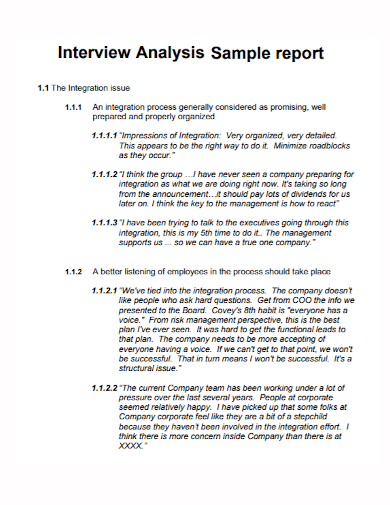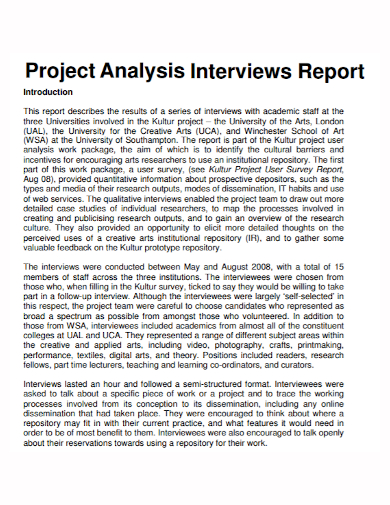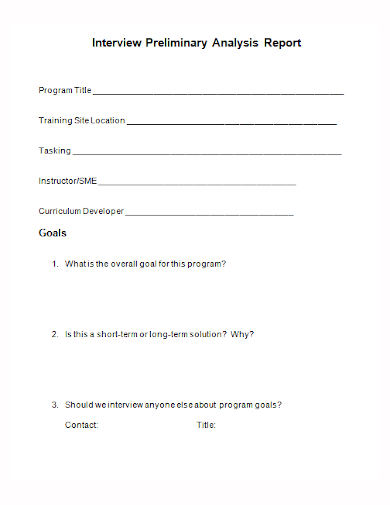Reports, or also called research paper, involves gathering factual studies and data to support a certain topic that you’re studying for. One of the most common ways to gather original data that will give new insights and knowledge to support your topic is through conducting interviews. Doing interviews is more than just making questions and asking them to your respondents; you also need to analyze and interpret their answers that will correspond with your study. Analyzing interview responses can be tricky especially if you don’t know how to do the analysis but this article can help you on making that analysis report. Read the article to know how to make an interview analysis report.
3+ Interview Analysis Report Samples
1. Interview Analysis Report
2. Project Interview Analysis Report
3. Interview Preliminary Analysis Report
4. Interview Group Analysis Report
What is an Interview Analysis?
An interview analysis, or also called narrative analysis, is the process of assessing and understanding the answers and responses of the respondents of your interview. Most qualitative methods of acquiring data using this type of analysis to highlight critical points of the answers of your respondents that you can use to back your research. It is the most common method of analyzing qualitative data due to its effectiveness in verifying your analysis through your respondents’ answers.
How to Make an Interview Analysis Report?
1. Read the Transcripts
The first thing you need to do is to gather your transcripts from your interviews and browse through them. On a sheet of paper or a notebook, take note of your first impressions. As you go along, you will begin to identify the common themes of all the transcripts. Highlight that as you will use it, to sum up, your data analysis.
The next thing to do is to go back and reach each transcript carefully. Take note of the important insights that correspond with your themes. Make sure to eradicate any biased answers.
2. Make Notes on the Transcripts
While you’re reading through your transcripts, using your highlighter or a stick-on note, label any relevant words, phrases, sentences, or sections with codes. The codes are the common patterns you identified in the transcripts. Those codes can be about actions, activities, concepts, opinions, processes, or any data you think is relevant to the common themes you’ve discovered in your transcripts.
3. Conceptualize the Data
The next thing to do is to align your data with the themes and codes you’ve discovered by creating categories and subcategories. You can combine some codes if they are similar to each other and eradicate those that are not relevant to your analysis.
4. Segment the Data
Segment your data by positioning and connecting your categories. Label each of your categories and then describe the connections between them. You can create a spreadsheet to compile and identify your data and each of the codes that you’ve identified later. This will help you in analyzing the level of relevance and impact of your data.
5. Analyze the Segments
Now that you’ve organized the data into categories, it’s time to determine the hierarchy (if there’s one) among your categories. For example, find out if one data category is more important than the other or you can come up with a figure to summarize your results. If you’ve gathered any quantitative data, you can also align it with your segmented data.
6. Write the Results of Your Analysis
Once you’ve completed all the steps mentioned above, it’s time to start writing the results of your findings for your research paper or report. With your insights, you can verify the theories you’ve used in your study, interpret your data with the relevant studies you’ve incorporated in your study, answer the main problems you’ve come up with, and complete your aims and objectives.
FAQs
What are the different types of interview analysis forms?
The most common forms of interview analysis are structural, functional, thematic, and dialogic.
What are the three types of interviews?
The three types of interviews are:
- Unstructured interviews: These are interviews that have few interview questions. They are usually informal types of interviews that are almost like a normal conversation. This style is used to discuss sensitive topics to help build rapport and make the interviewee get comfortable to discuss these topics with the interviewer.
- Structured interviews: These are interviews that strictly follow the interview protocol and questions to guide the interviewer to talk to their interviewee. This is a more rigid and formal interview style.
- Semistructured interviews: These are interviews that are a mix of structured and unstructured interviews. Interviewers use an interview protocol to guide them in the interview process but they can segway to ask additional questions to make the interview seem more conversational. It offers an opportunity for interviewers to probe the interviewee for more details.
It’s no secret that analyzing, interpreting, and writing the findings of your data, especially when it comes to analyzing interviews, is challenging. You need to stay focused and commit a lot of time to sort through your data and analyze any parts that can be useful for your study. When writing your analysis findings, be sure to write in a neutral and objective voice. To help you get started on writing your interview analysis report, download our free sample templates provided above!
Related Posts
FREE 4+ Restaurant Incident Report Samples in PDF MS Word ...
FREE 6+ Teachers Weekly Report Samples [ Accomplishment, Duty ...
FREE 9+ Building Inspection Report Samples in PDF MS Word
FREE 7+ Sample External Audit Reports in MS Words Pages
FREE 11+ Weekly Construction Report Samples in PDF MS Word
FREE 11+ External Audit Report Samples & Templates in PDF MS ...
FREE 15+ Site Investigation Report Samples in PDF DOC
FREE 10+ Psychological Assessment Report Samples [ Clinical ...
FREE 11+ Engineering Audit Report Samples & Templates in PDF ...
FREE 34+ Sample Report Writing Format Templates in PDF
FREE 10+ Retail Trade Report Samples in PDF MS Word
FREE 10+ Research and Development Report Samples in MS Word ...
FREE 18+ Sample Trip Reports in MS Word Apple Pages | PDF
FREE 8+ Sample Report Outline Templates in PDF Apple Pages ...
FREE 8+ Sample Report Outline Templates in PDF Apple Pages ...




